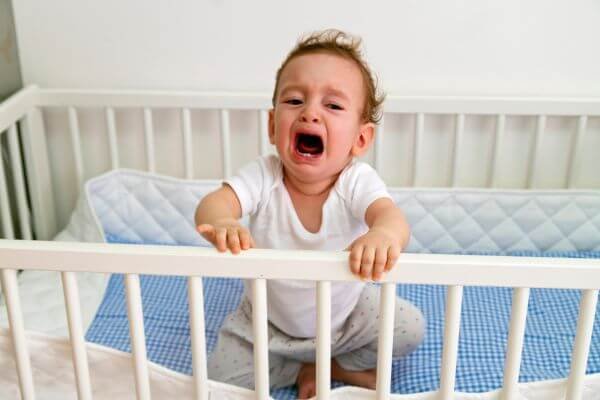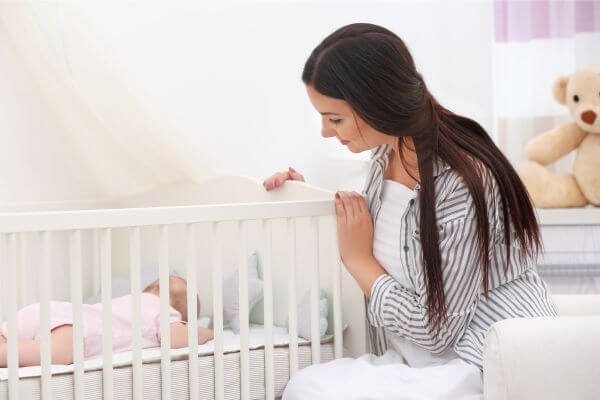Are you concerned about your baby rolling in the crib and hitting their head? Imagine the adorable sight of your baby rolling joyfully in their crib, only to be interrupted by the sound of a thud as they accidentally bump their precious head. As parents, witnessing such moments can be both heartwarming and concerning. In this guide, we delve into the common scenario of babies rolling in their cribs and hitting their heads, exploring what you can do to ensure their safety and well-being.

In this article, we will highlight the concern, stress the importance of safety, and fulfill our promise to equip you with valuable strategies to keep your baby safe while they explore their newfound mobility. Read on to discover effective ways to protect your baby from hitting their head while rolling in the crib.
Related: Top 8 Best Baby Travel Crib: A Safe And Convenient Traveling With Your Baby
Ensuring Crib Safety:
Protecting Your Baby from Potential Hazards
A safe crib is a cornerstone of your baby’s well-being, playing a vital role in preventing injuries and providing a secure sleep environment. By prioritizing crib safety, you can significantly reduce the risk of accidents. Here’s essential information to help you create a safe crib space for your little one:
Importance of a safe crib
A secure crib is crucial because it shields your baby from potential hazards and minimizes the likelihood of accidents. A well-designed crib provides a protective boundary, ensuring your baby stays safe during sleep and playtime.
Check for safety standards
Regularly inspect your baby’s crib for loose or broken parts, as they can pose serious risks. Check for any protruding screws, sharp edges, or splintered wood. Ensure the crib meets the recommended safety standards established by reputable organizations.
Proper mattress placement
The correct mattress placement is key to crib safety. Adjust the mattress height as your baby grows to prevent them from climbing out and potentially falling. Make sure the mattress is snugly fitted to the crib frame, leaving no gaps that could entrap your baby. A firm mattress provides optimal support, reducing the risk of suffocation or Sudden Infant Death Syndrome (SIDS).
By adhering to these crib safety guidelines, you can create a secure sleeping environment that promotes your baby’s well-being. Regularly assess the crib’s condition and adjust the mattress height accordingly, ensuring a safe and comfortable space for your precious little one to rest and grow.
Additionally, if you are looking for the best travel beds for toddlers, consider portable and lightweight options designed specifically for travel purposes. These travel beds provide familiar and safe sleeping space for your toddler while on the go. When selecting a travel bed, prioritize safety features, comfort, and ease of use to ensure a secure and enjoyable travel experience for your little one.
Creating a Safe Sleeping Environment:
Promoting Your Baby’s Peaceful Rest
When it comes to your baby’s sleep, ensuring a safe sleeping environment is paramount. By taking proactive measures, you can minimize the risk of suffocation and provide optimal comfort for your little one. Here are essential tips for creating a safe sleeping environment:
Eliminate suffocation hazards
To safeguard your baby, it’s crucial to remove pillows, blankets, and stuffed animals from the crib. These items can pose suffocation hazards and increase the risk of Sudden Infant Death Syndrome (SIDS). Instead, opt for a fitted sheet and a sleep sack, which provide warmth without compromising safety.

Optimal sleepwear
Choosing appropriate sleepwear for your baby is essential for their comfort and safety. Dress them in lightweight and breathable garments that are suitable for room temperature. Avoid overdressing or using heavy blankets, as overheating can increase the risk of sleep disturbances and discomfort.
Temperature control
Maintaining a comfortable room temperature plays a vital role in promoting safe sleep for your baby. Aim for a temperature range of 68 to 72 degrees Fahrenheit (20 to 22 degrees Celsius) to ensure a suitable sleep environment. Use a room thermometer to monitor the temperature and adjust it accordingly.
By following these guidelines, you can create a safe and conducive sleeping environment for your baby. Remove suffocation hazards, choose appropriate sleepwear, and maintain a comfortable room temperature to provide your little one with a peaceful and secure place to rest. Prioritizing their safety will give them peace of mind as they enjoy a restful sleep.
Additional Safety Measures:
Enhancing Your Baby’s Well-being
While ensuring crib safety and a secure sleeping environment are essential, there are additional measures you can take to further protect your baby. By implementing these safety strategies, you can enhance their safety and development. Here are valuable tips to consider:
Consider using crib bumpers or mesh liners
To safeguard your baby from hitting the crib rails, you may opt to use breathable crib bumpers or mesh liners. These protective barriers can cushion accidental bumps and prevent limb entrapment. However, it’s crucial to ensure that they are securely attached, avoiding any loose fabric that could pose a strangulation or suffocation risk.
Supervised naps and sleep
If your baby frequently hits their head while rolling in the crib, closely monitoring their sleep periods becomes paramount. Regularly check on them and use a reliable baby monitor to ensure their safety. By providing supervision, you can promptly intervene if necessary and create a safe sleeping environment.
Importance of tummy time
Tummy time is crucial for your baby’s development. While it may not directly address the issue of hitting the head in the crib, it helps strengthen their neck and shoulder muscles. Regularly engaging in supervised tummy time sessions allows your baby to develop the necessary strength and coordination for rolling and movement, potentially reducing the frequency of head-hitting incidents.
By implementing these additional safety measures, you can further protect your baby and promote their healthy development. Consider the use of crib bumpers or mesh liners for added cushioning, closely supervise naps and sleep, and prioritize supervised tummy time to support your baby’s physical growth. Remember, providing a safe environment goes hand in hand with fostering their overall well-being.
Final Words:
Ensuring Your Baby’s Safety and Well-being (Baby Rolling in Crib and Hitting Head)
In conclusion, taking prompt and proactive action to prevent injuries is crucial when it comes to your baby’s well-being. By implementing the recommended safety measures, such as ensuring crib safety, creating a secure sleeping environment, and considering additional safety measures like using baby bassinet rockers, baby travel cribs, and the best baby bouncers, you can provide optimal protection for your little one. Here’s a recap of the key points to remember:
Reiterate the importance of taking action to prevent injuries
It cannot be stressed enough how vital it is to prioritize your baby’s safety. By being aware of potential risks and actively addressing them, you can significantly reduce the likelihood of accidents and injuries. Whether it’s inspecting the crib for safety standards, eliminating suffocation hazards, or using specialized baby gear like baby bassinet rockers, baby travel cribs, and the best baby bouncers, your proactive efforts make a significant difference.

Encourage seeking professional advice
If you have ongoing concerns or encounter challenges in ensuring your baby’s safety, it is advisable to consult a healthcare professional. They can provide expert guidance, and tailored advice, and address any specific concerns you may have. Seeking professional advice ensures that you have the most accurate and personalized information for your baby’s unique needs.
Reinforce the message of ensuring a safe environment for the baby’s well-being: Above all, creating a safe environment for your baby should be a continuous priority. Regularly assess the crib’s safety, maintain optimal sleepwear and room temperature, and supervise your baby during sleep and playtime. Additionally, consider utilizing specialized baby gear like baby bassinet rockers, baby travel cribs, and the best baby bouncers, which offer added safety features and comfort for your little one.
Remember, by reiterating the importance of taking action, encouraging professional advice, and emphasizing the significance of a safe environment, you are actively working towards providing the best possible care for your baby. With your dedication and the implementation of proper safety measures, you can ensure a secure and nurturing environment where your baby can thrive and grow.
Related: Top 10 Best Cribs For Short Moms: Height-Friendly Cribs
FAQS
What Is Head Banging?
Head banging refers to a rhythmic and repetitive motion where a child repeatedly hits their head against a surface, such as a crib or a wall. It is a common behavior observed in some infants and toddlers during sleep or wakefulness.
When Does Head Banging Start In Children?
Head banging typically starts between the ages of 6 and 18 months, but it can begin earlier or later. It is most commonly seen in children between 18 and 24 months old, and it tends to decrease or stop completely by the age of 3.
How Long Does Head Banging Last?
The duration of head banging can vary from child to child. Some children engage in this behavior for only a few minutes, while others may do it for more extended periods, even up to an hour. However, most children outgrow head-banging by the age of 3 without any lasting negative effects.
What Are Signs Of Head Banging?
Signs of head banging include repetitive rhythmic movements of the head against a surface, such as a crib or a wall. The movements are usually firm but not violent. Head banging can occur during naptime, bedtime, or even during awake periods. It may be accompanied by other self-soothing behaviors, such as rocking or thumb-sucking.
Why Does Head Banging Happen In Babies And Infants?
The exact reasons for head banging in babies and infants are not fully understood. However, it is believed to serve various purposes. It can be a self-soothing technique that helps children relax and fall asleep. It may also be a way for them to seek attention or express frustration, especially if they have difficulty communicating their needs verbally.
What Can Parents Do About Infant Head Banging?
If your baby or infant engages in head banging, there are several steps you can take:
- Ensure a safe sleeping environment: Remove any potential hazards from the crib, such as loose bedding or objects that could cause injury. Create a secure space for your baby to minimize the risk of harm during head banging episodes.
- Monitor and observe: Keep a close eye on your baby during head banging episodes to ensure their safety. Use a reliable baby monitor if necessary.
- Provide alternative soothing techniques: Introduce alternative self-soothing techniques, such as providing a comfort object or playing calming music, to help your baby relax and fall asleep.
- Consult a healthcare professional: If you have concerns about your baby’s head banging behavior or if it becomes severe or disruptive, consult a healthcare professional for guidance and support.
Should You Use Crib Bumpers to Minimize the Impact of Baby Rolling in Crib Hitting Head?
It is generally not recommended to use crib bumpers to minimize the impact of a baby rolling in the crib and hitting its head. Crib bumpers can pose suffocation, entrapment, and strangulation hazards. The American Academy of Pediatrics advises against their use to reduce the risk of sleep-related accidents. Instead, focus on ensuring a safe sleeping environment by following the recommended crib safety guidelines and closely monitoring your baby during sleep.
Remember, each child is unique, and if you have concerns about your baby’s head-banging behavior, it is always best to consult a healthcare professional for personalized advice and support.






